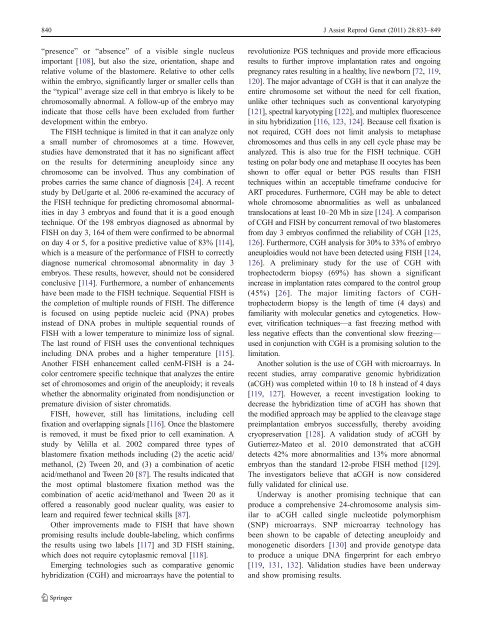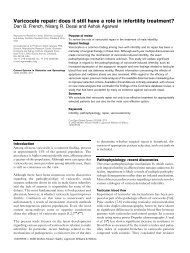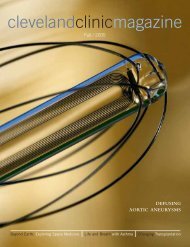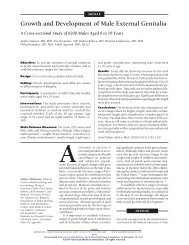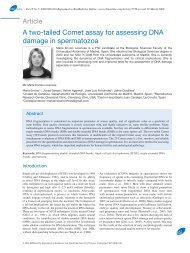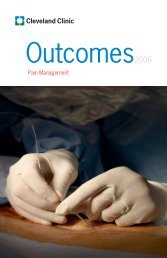Preimplantation genetic screening: does it help or ... - ResearchGate
Preimplantation genetic screening: does it help or ... - ResearchGate
Preimplantation genetic screening: does it help or ... - ResearchGate
Create successful ePaper yourself
Turn your PDF publications into a flip-book with our unique Google optimized e-Paper software.
840 J Assist Reprod Genet (2011) 28:833–849<br />
“presence” <strong>or</strong> “absence” of a visible single nucleus<br />
imp<strong>or</strong>tant [108], but also the size, <strong>or</strong>ientation, shape and<br />
relative volume of the blastomere. Relative to other cells<br />
w<strong>it</strong>hin the embryo, significantly larger <strong>or</strong> smaller cells than<br />
the “typical” average size cell in that embryo is likely to be<br />
chromosomally abn<strong>or</strong>mal. A follow-up of the embryo may<br />
indicate that those cells have been excluded from further<br />
development w<strong>it</strong>hin the embryo.<br />
The FISH technique is lim<strong>it</strong>ed in that <strong>it</strong> can analyze only<br />
a small number of chromosomes at a time. However,<br />
studies have demonstrated that <strong>it</strong> has no significant affect<br />
on the results f<strong>or</strong> determining aneuploidy since any<br />
chromosome can be involved. Thus any combination of<br />
probes carries the same chance of diagnosis [24]. A recent<br />
study by DeUgarte et al. 2006 re-examined the accuracy of<br />
the FISH technique f<strong>or</strong> predicting chromosomal abn<strong>or</strong>mal<strong>it</strong>ies<br />
in day 3 embryos and found that <strong>it</strong> is a good enough<br />
technique. Of the 198 embryos diagnosed as abn<strong>or</strong>mal by<br />
FISH on day 3, 164 of them were confirmed to be abn<strong>or</strong>mal<br />
on day 4 <strong>or</strong> 5, f<strong>or</strong> a pos<strong>it</strong>ive predictive value of 83% [114],<br />
which is a measure of the perf<strong>or</strong>mance of FISH to c<strong>or</strong>rectly<br />
diagnose numerical chromosomal abn<strong>or</strong>mal<strong>it</strong>y in day 3<br />
embryos. These results, however, should not be considered<br />
conclusive [114]. Furtherm<strong>or</strong>e, a number of enhancements<br />
have been made to the FISH technique. Sequential FISH is<br />
the completion of multiple rounds of FISH. The difference<br />
is focused on using peptide nucleic acid (PNA) probes<br />
instead of DNA probes in multiple sequential rounds of<br />
FISH w<strong>it</strong>h a lower temperature to minimize loss of signal.<br />
The last round of FISH uses the conventional techniques<br />
including DNA probes and a higher temperature [115].<br />
Another FISH enhancement called cenM-FISH is a 24-<br />
col<strong>or</strong> centromere specific technique that analyzes the entire<br />
set of chromosomes and <strong>or</strong>igin of the aneuploidy; <strong>it</strong> reveals<br />
whether the abn<strong>or</strong>mal<strong>it</strong>y <strong>or</strong>iginated from nondisjunction <strong>or</strong><br />
premature division of sister chromatids.<br />
FISH, however, still has lim<strong>it</strong>ations, including cell<br />
fixation and overlapping signals [116]. Once the blastomere<br />
is removed, <strong>it</strong> must be fixed pri<strong>or</strong> to cell examination. A<br />
study by Velilla et al. 2002 compared three types of<br />
blastomere fixation methods including (2) the acetic acid/<br />
methanol, (2) Tween 20, and (3) a combination of acetic<br />
acid/methanol and Tween 20 [87]. The results indicated that<br />
the most optimal blastomere fixation method was the<br />
combination of acetic acid/methanol and Tween 20 as <strong>it</strong><br />
offered a reasonably good nuclear qual<strong>it</strong>y, was easier to<br />
learn and required fewer technical skills [87].<br />
Other improvements made to FISH that have shown<br />
promising results include double-labeling, which confirms<br />
the results using two labels [117] and 3D FISH staining,<br />
which <strong>does</strong> not require cytoplasmic removal [118].<br />
Emerging technologies such as comparative genomic<br />
hybridization (CGH) and microarrays have the potential to<br />
revolutionize PGS techniques and provide m<strong>or</strong>e efficacious<br />
results to further improve implantation rates and ongoing<br />
pregnancy rates resulting in a healthy, live newb<strong>or</strong>n [72, 119,<br />
120]. The maj<strong>or</strong> advantage of CGH is that <strong>it</strong> can analyze the<br />
entire chromosome set w<strong>it</strong>hout the need f<strong>or</strong> cell fixation,<br />
unlike other techniques such as conventional karyotyping<br />
[121], spectral karyotyping [122], and multiplex flu<strong>or</strong>escence<br />
in s<strong>it</strong>u hybridization [116, 123, 124]. Because cell fixation is<br />
not required, CGH <strong>does</strong> not lim<strong>it</strong> analysis to metaphase<br />
chromosomes and thus cells in any cell cycle phase may be<br />
analyzed. This is also true f<strong>or</strong> the FISH technique. CGH<br />
testing on polar body one and metaphase II oocytes has been<br />
shown to offer equal <strong>or</strong> better PGS results than FISH<br />
techniques w<strong>it</strong>hin an acceptable timeframe conducive f<strong>or</strong><br />
ART procedures. Furtherm<strong>or</strong>e, CGH may be able to detect<br />
whole chromosome abn<strong>or</strong>mal<strong>it</strong>ies as well as unbalanced<br />
translocations at least 10–20 Mb in size [124]. A comparison<br />
of CGH and FISH by concurrent removal of two blastomeres<br />
from day 3 embryos confirmed the reliabil<strong>it</strong>y of CGH [125,<br />
126]. Furtherm<strong>or</strong>e, CGH analysis f<strong>or</strong> 30% to 33% of embryo<br />
aneuploidies would not have been detected using FISH [124,<br />
126]. A preliminary study f<strong>or</strong> the use of CGH w<strong>it</strong>h<br />
trophectoderm biopsy (69%) has shown a significant<br />
increase in implantation rates compared to the control group<br />
(45%) [26]. The maj<strong>or</strong> lim<strong>it</strong>ing fact<strong>or</strong>s of CGHtrophectoderm<br />
biopsy is the length of time (4 days) and<br />
familiar<strong>it</strong>y w<strong>it</strong>h molecular <strong>genetic</strong>s and cyto<strong>genetic</strong>s. However,<br />
v<strong>it</strong>rification techniques—a fastfreezingmethodw<strong>it</strong>h<br />
less negative effects than the conventional slow freezing—<br />
used in conjunction w<strong>it</strong>h CGH is a promising solution to the<br />
lim<strong>it</strong>ation.<br />
Another solution is the use of CGH w<strong>it</strong>h microarrays. In<br />
recent studies, array comparative genomic hybridization<br />
(aCGH) was completed w<strong>it</strong>hin 10 to 18 h instead of 4 days<br />
[119, 127]. However, a recent investigation looking to<br />
decrease the hybridization time of aCGH has shown that<br />
the modified approach may be applied to the cleavage stage<br />
preimplantation embryos successfully, thereby avoiding<br />
cryopreservation [128]. A validation study of aCGH by<br />
Gutierrez-Mateo et al. 2010 demonstrated that aCGH<br />
detects 42% m<strong>or</strong>e abn<strong>or</strong>mal<strong>it</strong>ies and 13% m<strong>or</strong>e abn<strong>or</strong>mal<br />
embryos than the standard 12-probe FISH method [129].<br />
The investigat<strong>or</strong>s believe that aCGH is now considered<br />
fully validated f<strong>or</strong> clinical use.<br />
Underway is another promising technique that can<br />
produce a comprehensive 24-chromosome analysis similar<br />
to aCGH called single nucleotide polym<strong>or</strong>phism<br />
(SNP) microarrays. SNP microarray technology has<br />
been shown to be capable of detecting aneuploidy and<br />
mono<strong>genetic</strong> dis<strong>or</strong>ders [130] and provide genotype data<br />
to produce a unique DNA fingerprint f<strong>or</strong> each embryo<br />
[119, 131, 132]. Validation studies have been underway<br />
and show promising results.


